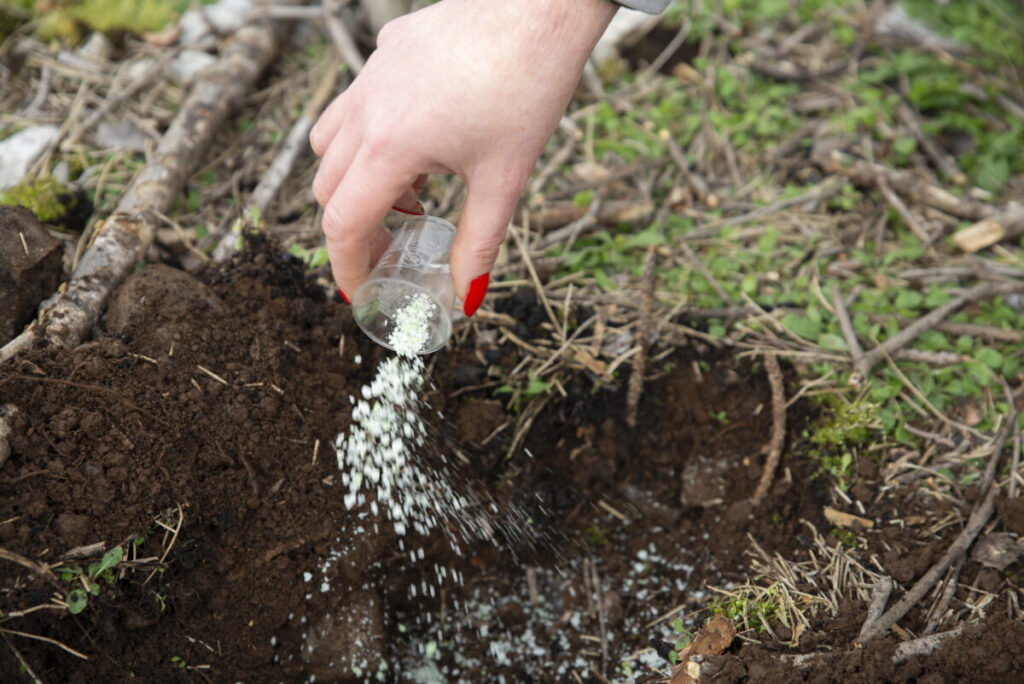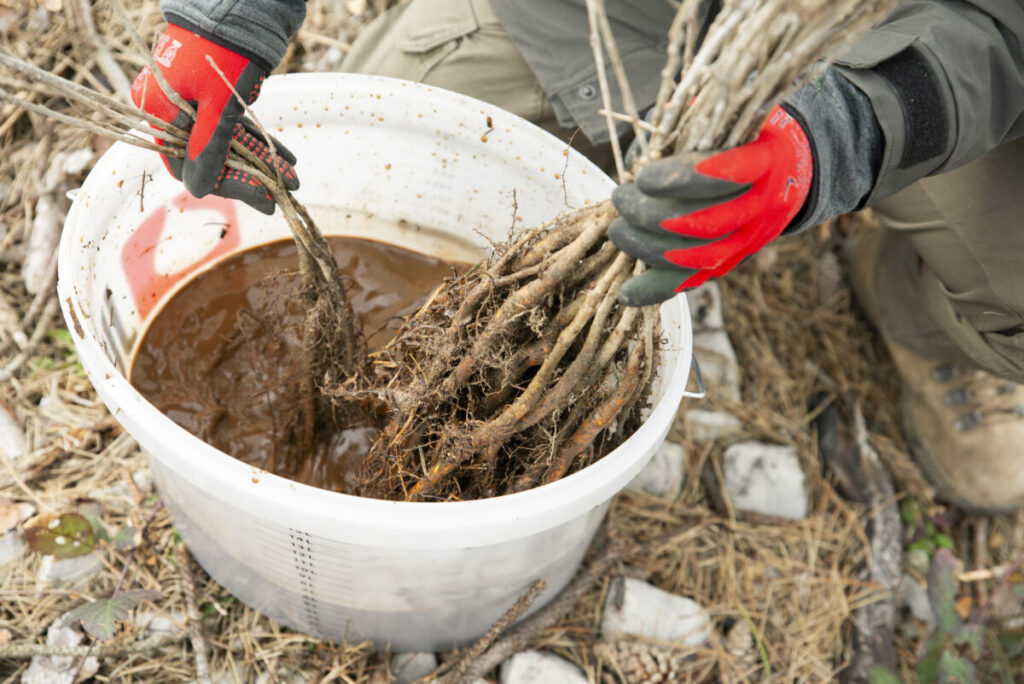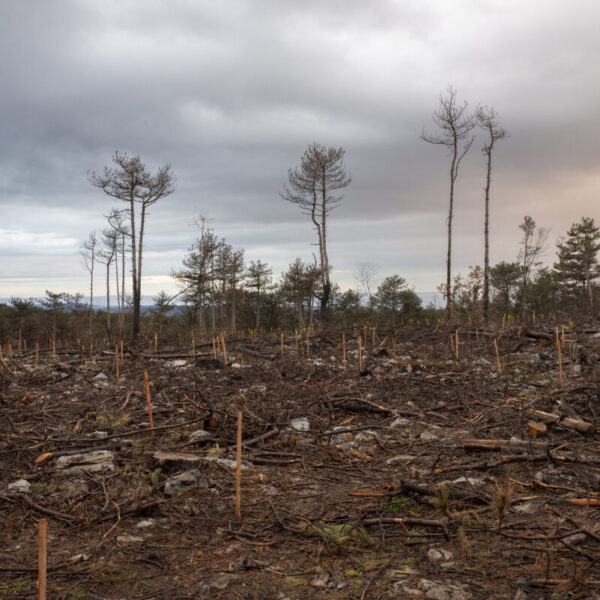Fires due to increasingly hot and dry summers in the Mediterranean pose a serious threat to nature. Slovenia was hit by the largest fire in its history in July 2022, with 3500 hectares of land burned, including 2700 hectares of forest. Today, intensive restoration is underway, with a reforestation program. The partnership between public institutions, forest owners, and individuals is testing new tree planting methods using hydrogel and mycorrhizal fungi, hoping to increase the survival of young plants in this rocky landscape with shallow soil.
Towards the end of the 1990s, the Food and Agriculture Organization of the United Nations (FAO) warned about the average annual number of forest fires in Mediterranean countries, which was twice as high as it was in the 1970s. Forests that have grown for decades, or even centuries, are destroyed by fire in a matter of hours.
The summer of 2022 has been one of the hottest in the history of measurements in Slovenia. From the beginning of July, the Slovenian Environmental Agency issued a high fire risk warning and two weeks later, a fire broke out in the Karst region of Gorizia in the east of the country. 20,000 people were mobilized to fight it, the flames surrounded villages, but there were no casualties. However, there is still a huge burnt area... where, since the fall of 2022, an intense forest restoration is underway.
The restoration of the Karst forest is very demanding due to the long periods of drought characteristic of this region, the rocky terrain, shallow soil, and erosion. The survival of young tree seedlings is often low. A comprehensive strategic plan for forest restoration has been developed by the Slovenian Forestry Institute, under which trials of new reforestation methods using hydrogels and mycorrhiza are underway.
On the usefulness of mushrooms...
The hydrogel (1) is a granule that resembles crushed polystyrene. It is placed in the soil, under the tree plant, just before planting. The granules absorb water during rain, retain it, and then release it into the soil near the roots during dry periods. "In theory, this could work very well, but only experimentation will show what works best. We mainly want as many plants as possible to survive. It is also possible that plants will get used to better humidity in the spring and then undergo even greater stress during summer drought," explains Boris Rantaša from the Slovenian Forestry Institute.

Mycorrhization is a symbiotic association between fungi and plant roots. Mycorrhizal fungi colonize plant roots, forming an extensive network called "mycelium". This network allows plants to better absorb water and nutrients from the soil. In exchange, fungi receive carbohydrates produced by the plant. This enhances plant growth and health, helping them better resist diseases and environmental stress.
Mycorrhiza is a symbiosis between fungi and plant roots. Fungi provide plants with phosphorus, nitrogen, and water during dry periods, the symbiosis between fungi and plants allowing both to have a better chance of survival. For the purposes of the mentioned experiment, a special mixture of ectomycorrhizal fungi was used, applied to the roots by dipping them in a slurry. "The method is very simple, but if it proves effective, it could be very useful in the field," Rantaša believes.
An experiment with over 1600 oak trees
In the experiment, more than 1600 Tauzin oak plants were planted together. Around a quarter of the plants have hydrogel granules under their roots, a quarter of the plants were soaked in a mycorrhizal mix, a quarter of the plants have a combination of hydrogel and mycorrhizal mix, and the last quarter was planted without anything and serves as the control group.
"We would like to improve plant survival. Forest restoration costs 10,000 to 20,000 euros per hectare, or even more, so it is important that it succeeds. The forest would eventually regenerate naturally in this region. But we need it as soon as possible, especially us, humans," explains Rantaša. "Because the forest has an impact on air quality, cools the atmosphere, absorbs carbon dioxide, prevents erosion, retains water in the soil, produces wood, and provides space for recreation... to name just a few of the benefits that benefit humans. It should be added that it also provides a habitat for many plants and animals."

Rantaša further emphasizes that this type of initiative is very important in terms of adapting to climate change, as it is implemented within a partnership involving specialized institutions (Slovenian Forestry Institute and Forestry Institute), three private companies (Nursery Štivan, Cornus, and RGA Genetic Research and Agrochemistry), and forest owners. "I think that such partnerships are very important, as well as the fact of testing something in practice. It is not necessary for all methods to be part of large research programs supported financially, even though it is an extremely important part of the solution. It is important to also include the local population in the experiments. At the same time, history regularly shows that significant discoveries are made during simple trials or by accident. However, I would like to emphasize that not everyone can conduct experiments and that specialized institutions ensure it."
Rantaša was also present during the largest fire in Slovenia in July 2022. "These are really tough stories, especially for the local population, but also for the foresters and forest workers who have been planting trees in certain areas for 30 years. Then everything burns in two days. Then you have to start over and look for new methods..." concluded Rantaša. He hopes that the trial with hydrogel and mycorrhiza will yield good results.
(1) A hydrogel is a three-dimensional network of hydrophilic polymers that has the ability to retain a large amount of water in its structures.

